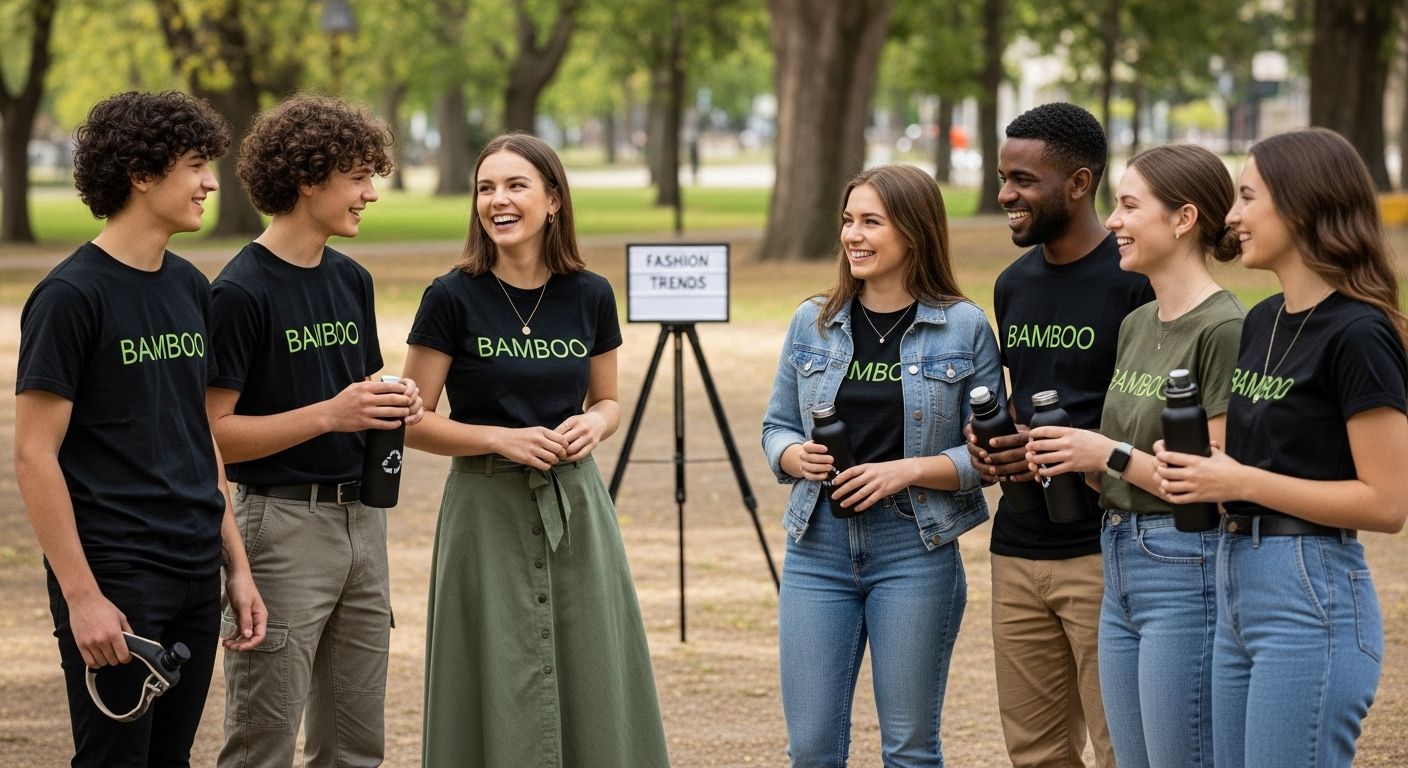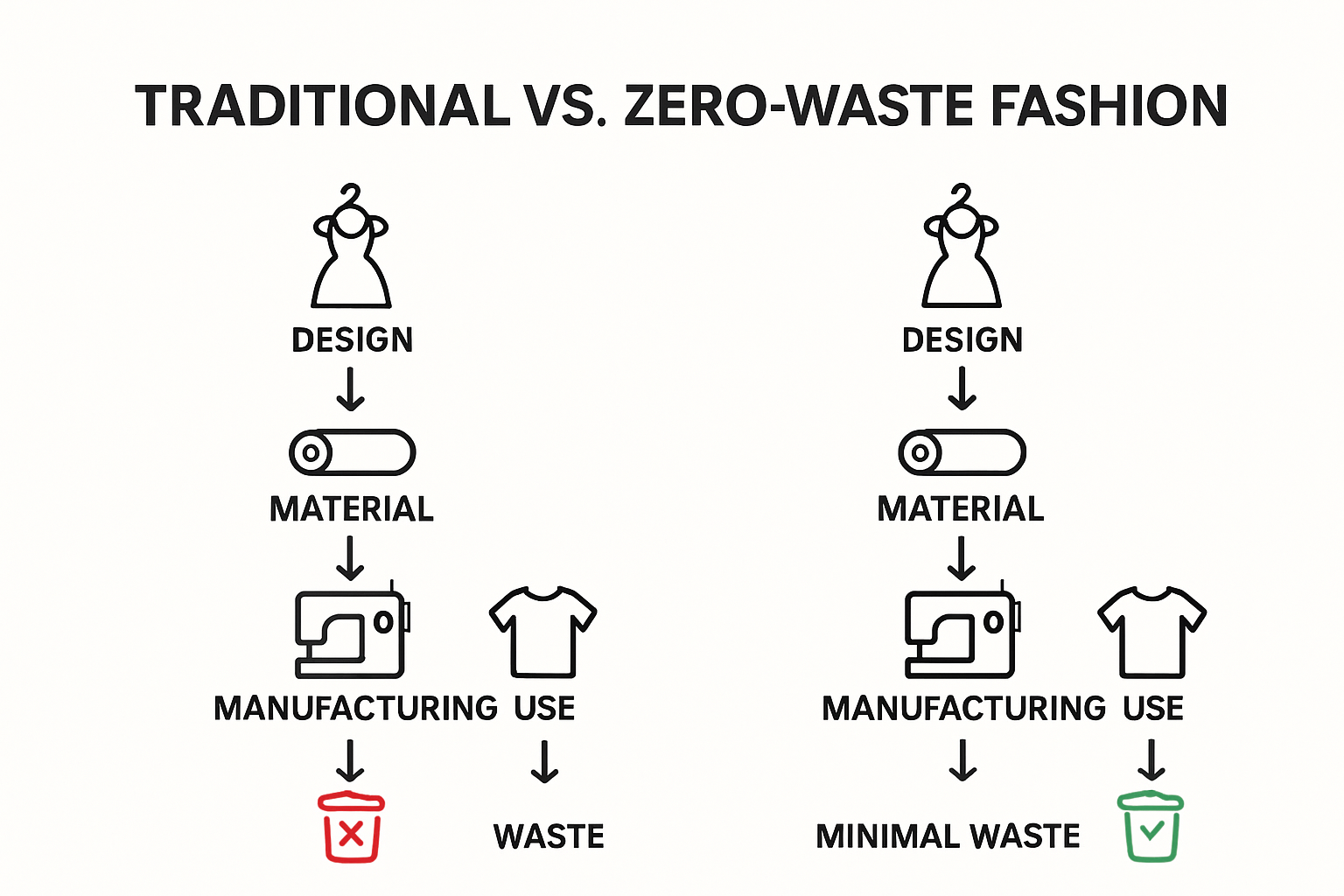Tax included and shipping calculated at checkout

Sustainable fashion is showing up everywhere, from runway shows to teenage TikTok hauls. What seems even more surprising is that about 80 to 90 percent of a garment’s environmental impact is set before you ever slip it on—right at the design stage, not in the factory or your closet. Most people expect the buzz to be all about recycled fabric and eco materials, but the real shakeup is happening in the way clothes are sketched, cut, and imagined from the very start.
Table of Contents
- What Makes Fashion Sustainable Today
- Popular Eco-Friendly Materials And Styles
- Best Sustainable Brands For Online Shoppers
- How To Embrace Green Fashion In Daily Life
Quick Summary
| Takeaway | Explanation |
|---|---|
| Sustainable fashion begins with design choices. | 80 to 90% of a clothing’s sustainability is determined during its design, emphasizing responsible material use and production methods. |
| Choose brands that prioritize transparency. | Look for companies that provide clear information about their sourcing, manufacturing practices, and certifications, to ensure ethical production. |
| Invest in versatile and durable clothing. | Focus on quality pieces that can be worn in various ways and are constructed to last, reducing waste over time. |
| Support innovative sustainable practices. | Engage with practices like zero-waste design and recycling programs that minimize environmental impact during garment production. |
| Make informed purchasing decisions. | Consider the environmental effects of different materials and production methods before buying, ensuring your choices support sustainability. |
What Makes Fashion Sustainable Today
Sustainable fashion represents a transformative approach to clothing production that prioritizes environmental responsibility, ethical manufacturing, and long-term ecological preservation. The contemporary fashion industry is experiencing a critical shift towards more conscious design and production methods that minimize negative environmental impacts.
Innovative Design and Material Selection
The foundation of sustainable fashion begins with strategic design choices. According to Columbia University’s Earth Institute, 80 to 90 percent of a clothing item’s sustainability is determined during its design stage. Designers are now embracing innovative techniques like zero-waste pattern cutting, which dramatically reduces fabric waste and carbon footprints.
Zero-waste design approaches challenge traditional manufacturing by reimagining how garments are conceived and constructed. Researchers exploring zero-waste fashion have demonstrated that thoughtful pattern making can generate little to no textile waste during production. This method represents a significant departure from conventional manufacturing, where substantial fabric remnants typically end up in landfills.
Emerging Sustainable Technologies
Biodesign is revolutionizing sustainable fashion through groundbreaking material innovations. Emerging biodesign technologies are exploring living materials and biologically inspired processes to create textiles with minimal environmental impact. These cutting-edge approaches include developing microbial leather cultured from bacterial cellulose and creating yarns derived from algae, offering remarkable alternatives to traditional resource-intensive textile production.
These technological advancements represent more than experimental curiosities. They demonstrate a profound reimagining of fashion’s relationship with natural ecosystems. By integrating biological processes and renewable materials, designers can create clothing that not only looks appealing but also contributes positively to environmental conservation.
Holistic Sustainability Approach
Sustainable fashion transcends mere material selection. It encompasses a comprehensive approach that considers environmental, social, and economic factors throughout the entire clothing lifecycle. This means evaluating everything from raw material sourcing and manufacturing processes to worker conditions, transportation emissions, and eventual product disposal or recycling.
Consumers are increasingly demanding transparency and ethical practices from fashion brands. They want to understand the complete journey of their clothing – from initial design concept to final product. This shift in consumer consciousness is driving fashion brands to adopt more responsible and accountable production methods, ultimately pushing the entire industry towards more sustainable practices.
The future of fashion lies in its ability to balance aesthetic appeal with environmental stewardship. By embracing innovative design, advanced technologies, and a holistic understanding of sustainability, the fashion industry can transform from a significant environmental burden to a potential catalyst for positive ecological change.
Popular Eco-Friendly Materials and Styles
The sustainable fashion movement is revolutionizing clothing production through innovative materials and design approaches that prioritize environmental responsibility. Modern consumers are increasingly seeking apparel that not only looks stylish but also minimizes ecological impact.
Natural and Regenerative Textiles
Natural materials are at the forefront of sustainable fashion, offering environmentally friendly alternatives to synthetic fabrics. Research from Columbia University highlights the significant potential of materials like hemp, ramie, and bamboo in creating eco-conscious clothing. Regenerative cotton stands out as a particularly promising textile, grown without harmful pesticides and fertilizers, actively improving soil health and reducing environmental degradation.
Hemp fabric emerges as a standout sustainable material. Unlike conventional cotton, hemp requires minimal water, grows quickly, and naturally resists pests. Its durability and versatility make it an excellent choice for environmentally conscious consumers seeking long-lasting clothing options. The fabric’s natural properties allow it to be transformed into everything from lightweight summer wear to robust winter garments.
To help readers quickly compare different types of sustainable materials highlighted in the article, the following table summarizes the key aspects, benefits, and examples of each:
| Material Type | Key Benefits | Examples |
|---|---|---|
| Natural & Regenerative Textiles | Minimal chemicals; improves soil; renewable resources | Hemp, Regenerative Cotton, Bamboo |
| Innovative Biomimetic Materials | Designed to decompose naturally; lower long-term impact | Algae Yarn, Bacterial Cellulose |
| Recycled Materials | Reduces waste and pollution; utilizes existing resources | Recycled Polyester, Plastic Bottles |
Innovative Biomimetic and Recycled Materials
The Biomimicry Institute emphasizes the critical importance of designing textiles that can decompose naturally, reducing long-term environmental impact. Cutting-edge materials are now being developed with end-of-life considerations built into their fundamental design. Innovations include fabrics made from recycled plastic bottles, agricultural waste, and even bacterial cellulose.
Recycled polyester represents a significant breakthrough in sustainable fashion. By transforming plastic waste into high-quality textile fibers, designers can create clothing that simultaneously reduces environmental pollution and provides functional, attractive garments. This approach directly addresses the massive global challenge of plastic waste while offering consumers stylish, eco-friendly clothing options.
Zero-Waste Design Techniques
Zero-waste fashion design transforms how clothing is conceptualized and created. This approach goes beyond material selection, focusing on pattern-cutting techniques that utilize entire fabric widths without generating waste. Designers using zero-waste methods carefully plan garment shapes to minimize fabric remnants, effectively turning what was once considered waste into an integral part of the design process.

Contemporary sustainable styles embrace minimalism, versatility, and timeless aesthetics. Instead of following rapid trend cycles, eco-conscious fashion emphasizes classic silhouettes and high-quality construction that transcends seasonal changes. This approach encourages consumers to invest in fewer, more durable pieces that can be mixed, matched, and worn for extended periods.
The evolution of sustainable materials and design techniques demonstrates that environmental responsibility and fashion can coexist beautifully. As technology advances and consumer awareness grows, we can expect even more innovative solutions that challenge traditional manufacturing paradigms and create a more sustainable future for the fashion industry.
Best Sustainable Brands for Online Shoppers
Navigating the world of sustainable fashion requires understanding how brands approach environmental and ethical responsibilities. Online shoppers seeking eco-conscious clothing now have multiple options that prioritize sustainability throughout their production processes.
Transparency and Ethical Production Standards
Sustainable fashion experts emphasize the critical importance of brand transparency when selecting environmentally responsible clothing. Consumers increasingly demand comprehensive insights into sourcing, labor conditions, and overall environmental impact. Brands that provide detailed information about their supply chains, manufacturing processes, and sustainability initiatives are gaining significant consumer trust.
Ethical certification has become a key indicator of a brand’s commitment to sustainable practices. Look for certifications like Global Organic Textile Standard (GOTS), Fair Trade, and B Corp, which validate a company’s environmental and social responsibility. These certifications ensure that clothing is produced under fair working conditions while minimizing ecological damage.
Supply Chain and Manufacturing Innovations
The University of Delaware’s Sustainable Apparel Initiative recommends evaluating brands based on their comprehensive approach to eliminating waste across production processes. Innovative brands are now implementing end-of-life strategies that include recycling programs, circular design principles, and materials that can be easily repurposed or biodegraded.
Some forward-thinking brands are developing closed-loop production systems where clothing materials are continuously recycled and reused. This approach dramatically reduces waste and minimizes the environmental footprint associated with traditional textile manufacturing. Consumers can support these initiatives by choosing brands that demonstrate a genuine commitment to sustainable innovation.
Considerations for Sustainable Online Shopping
Research on clothing sustainability suggests that while rental, resale, and recycling services aim to reduce fashion’s environmental impact, they are not always as beneficial as perceived. Online shoppers should critically evaluate these services, considering factors like transportation emissions and energy-intensive processing.
When shopping online for sustainable fashion, consider these key factors:
- Material sourcing: Prioritize brands using organic, recycled, or regenerative materials
- Production transparency: Select brands that provide detailed information about their manufacturing processes
- Longevity: Choose high-quality pieces designed for extended use
- Certifications: Look for recognized sustainability and ethical production standards
The future of online fashion shopping lies in supporting brands that demonstrate a holistic commitment to environmental stewardship. By making informed choices, consumers can drive meaningful change in the fashion industry, encouraging more brands to adopt sustainable practices and reduce their ecological impact.
How to Embrace Green Fashion in Daily Life
Embracing sustainable fashion is more than a trend. It represents a profound lifestyle choice that empowers individuals to make meaningful environmental contributions through conscious clothing decisions. By understanding and implementing green fashion practices, anyone can transform their wardrobe into a powerful tool for ecological responsibility.
Strategic Wardrobe Management
Earth Day researchers highlight innovative approaches to reducing fashion’s environmental impact. Mindful consumption becomes the cornerstone of sustainable style, encouraging individuals to prioritize quality over quantity and make intentional purchasing decisions.
Key strategies for building a sustainable wardrobe include:
For readers seeking actionable strategies, this table outlines practical steps for building a sustainable wardrobe as described in the article:
| Sustainable Wardrobe Strategy | Description |
|---|---|
| Invest in Versatile, High-Quality Pieces | Choose items that match easily and last longer |
| Pick Timeless Designs | Select styles that don’t go out of fashion |
| Favor Natural, Durable Materials | Opt for fabrics like hemp or cotton that withstand repeated wear |
| Maintain and Repair Clothing | Extend item lifespan through care and basic repairs |
- Investing in versatile, high-quality pieces that can be mixed and matched
- Choosing timeless designs that transcend seasonal trends
- Selecting natural, durable materials that withstand repeated wear
- Maintaining and repairing clothing to extend its lifecycle
By adopting these principles, consumers can significantly reduce textile waste and minimize their fashion-related environmental footprint.

Innovative Sustainable Practices
Columbia University’s State of the Planet recommends several practical approaches to incorporating sustainable practices into daily fashion choices. Zero-waste pattern techniques and designing for disassembly represent cutting-edge strategies that individuals can support through conscious consumption.
Practical actions include:
- Participating in clothing swap events
- Supporting local secondhand and vintage stores
- Learning basic clothing repair skills
- Exploring rental and sharing platforms for occasional wear items
These approaches not only reduce individual environmental impact but also challenge traditional consumption patterns in the fashion industry.
Slow Fashion and Ethical Consumption
The Istituto Europeo di Design emphasizes slow fashion as a holistic approach to sustainable style. This philosophy goes beyond material selection, focusing on responsible consumption, ethical manufacturing, and long-term environmental considerations.
Transforming personal fashion habits requires a multifaceted approach:
- Research brand sustainability practices before purchasing
- Prioritize companies with transparent supply chains
- Understand the environmental impact of different textile production methods
- Support local and small-scale designers committed to sustainable practices
Each purchasing decision becomes an opportunity to support broader environmental sustainability goals. By treating clothing as a long-term investment rather than a disposable commodity, individuals can make significant contributions to reducing fashion’s ecological footprint.
The journey toward sustainable fashion is ongoing and evolving. It requires continuous learning, adaptation, and a commitment to making thoughtful choices that prioritize both personal style and environmental responsibility. As consumers become more informed and engaged, the collective impact of individual actions can drive meaningful change in the global fashion industry.
Frequently Asked Questions
What are the main principles of sustainable fashion?
Sustainable fashion focuses on environmentally responsible design, ethical manufacturing, and long-term ecological preservation throughout a garment’s lifecycle.
How does the design stage impact the sustainability of clothing?
Approximately 80 to 90 percent of a clothing item’s sustainability is determined during the design stage, which includes choices related to materials, production methods, and overall garment construction.
What are some popular eco-friendly materials used in sustainable fashion?
Common eco-friendly materials include natural textiles like hemp and regenerative cotton, as well as innovative materials such as recycled polyester and biomimetic fabrics that decompose naturally.
What is zero-waste fashion design?
Zero-waste fashion design is an approach that focuses on creating garments without producing textile waste, often using strategic pattern-cutting techniques that utilize the entire fabric width.
Make Sustainable Fashion a Reality With Vasita.shop
Are you ready to turn the sustainable fashion trends you just read about into tangible choices for your wardrobe? If you have ever wondered how to shop for quality clothing that reflects zero-waste design, eco-friendly materials, and timeless style, Vasita.shop makes it easy to start living these values. Our carefully curated collections give you access to durable, versatile pieces for men and women, so you can reduce textile waste and make every item count.

Join other conscious shoppers who choose clear supply chains and ethical brands every day. Explore our latest arrivals designed with both future-forward style and environmental impact in mind. Discover how shopping at Vasita.shop supports your commitment to a more thoughtful and sustainable wardrobe. Start browsing now and see how your choices make a difference.



